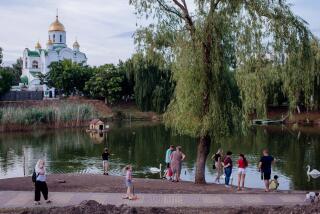Eastern Europe: Off the beaten path and into the Old World
- Share via
For travelers wishing to veer a bit off the beaten path, Eastern Europe has a lot to offer, and it is getting increasingly popular with Americans looking for an authentic taste of Old World life. Times staff writer Susan Spano took a peek at some Eastern European destinations, some familiar and some unknown. Here are a few of her reports from the eastern front.
 The Danube’s green waltz into Romania
The Danube’s green waltz into Romania
At the end of its 1,771-mile journey across Europe, the mighty Danube River seems to give up trying to reach the Black Sea. It turns north, away from the coast, crosses the lonely steppe country, then frays into myriad channels, marshes, swamps and lakes edged by waterlogged willow trees. Colonies of birds fly in from Asia, Africa and Siberia. In the stalled, murky water, giant carp and catfish lurk, sought by fishermen who live in villages that can be reached only by boat.
 Dresden’s spirit soars once more
Dresden’s spirit soars once more
You can’t get lost in Dresden. Wherever you go, you can see the stately white dome of the Frauenkirche, as much a landmark in this eastern German city as St. Peter’s is in Rome. It isn’t just that the church towers 300 feet above Dresden’s lovely Baroque skyline, that its colossal dome was an architectural marvel when consecrated in 1734 or that it stood for religious tolerance in a Protestant city ruled by the Catholic electors of Saxony. Even its extraordinary acoustics, which inspired composer Richard Wagner, don’t fully explain its profound meaning to Dresden and the world.
 Montenegro plays understudy to the Riviera
Montenegro plays understudy to the Riviera
A few intrepid travelers came here for suntans and seafood in the Soviet era, when Montenegro was a part of the Federal People’s Republic of Yugoslavia and hotel rooms were a steal. But the breakup of the former Yugoslavia, of which Serbia and Montenegro were a part, in the early 1990s, followed by a dark decade of ethnic cleansing and war, virtually erased the region from the tourist map. Now, with peace restored and all but two of the six republics that made up the former Yugoslavia independent, vacationers have started returning to the southern Balkans.
 Budapest, so Nouveau
Budapest, so Nouveau
Two remarkable things happened in Budapest around 1900: The city shot up almost overnight, and Art Nouveau arrived, reshaping the face of Hungary’s capital along glorious new lines. It was a happy coincidence for Budapest then and for visitors now, especially those who have a passion for Art Nouveau, which put its richly ornamental stamp on buildings, furniture, glass, ceramics, textiles and jewelry.
More to Read
Sign up for The Wild
We’ll help you find the best places to hike, bike and run, as well as the perfect silent spots for meditation and yoga.
You may occasionally receive promotional content from the Los Angeles Times.






